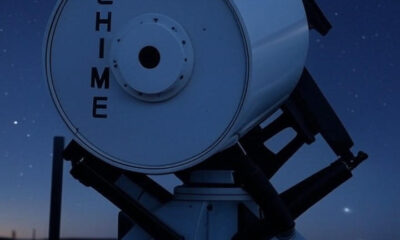Science
CHIME Telescope Discovers Brightest Fast Radio Burst Ever

Fast radio bursts (FRBs) have long intrigued astronomers due to their brief yet powerful emissions of radio waves. A significant breakthrough occurred when the Canadian Hydrogen Intensity Mapping Experiment (CHIME) telescope detected the brightest FRB to date, known as FRB 20250316A. This event, identified in March 2025, challenges existing theories about the origins of these mysterious cosmic phenomena.
The CHIME telescope, situated in British Columbia, has transformed FRB detection since its launch in 2018. Its innovative design, featuring four cylindrical reflectors, allows it to scan vast areas of the sky daily. This capability led to the discovery of over 500 FRBs in its inaugural year alone, as reported by MIT News. Researchers have differentiated between one-off events and repeating bursts, indicating a complex array of mechanisms behind these signals.
Record-Breaking Discovery
FRB 20250316A, dubbed “Radio Brightest Flash of All Time,” originates from the spiral galaxy NGC 4141, located approximately 130 million light-years away in the Ursa Major constellation. Unlike most FRBs traced back to distant galaxies, this relatively nearby source permits closer examination. This proximity raises questions about established theories that often associate FRBs with extreme astrophysical environments, such as magnetars or mergers of black holes.
Astronomers utilized CHIME’s upgraded outrigger stations for precise localization, narrowing the burst’s origin to within just 13 parsecs. This level of accuracy is remarkable for a non-repeating event. A study published in The Astrophysical Journal Letters highlights that the burst’s source lies in the galaxy’s outer regions, far from the active star-forming regions typically linked to such energetic outbursts.
Challenging Existing Theories
The implications of this discovery are significant. Magnetars, which are highly magnetized neutron stars, have been primary candidates for FRBs, particularly following a 2020 event in the Milky Way linked to one. However, the location of RBFLOAT within an older, quiescent stellar population contradicts this model, as magnetars are generally found in younger galactic environments. “This burst is in a surprising location,” noted a researcher, suggesting alternative progenitors such as colliding neutron stars or unusual white dwarfs.
Additionally, the one-off nature of RBFLOAT contrasts with repeaters, which some theories link to different processes. Excitement about this discovery is evident among astronomers and space agencies, including the Canadian Space Agency, who are actively debating whether FRBs represent distinct classes of events.
CHIME’s achievements are a product of international collaboration, involving institutions such as the University of Toronto, McGill University, and MIT. Recent enhancements, including new outriggers in California and West Virginia, allow for precise triangulation, as reported by Green Bank Observatory. These advancements not only pinpointed RBFLOAT’s location but also hold promise for mapping additional FRBs, potentially uncovering their energy sources.
Looking forward, integrating data from observatories like the James Webb Space Telescope could provide valuable optical counterparts, further enhancing our understanding. As one researcher remarked on social media, this discovery “challenges magnetar theories,” prompting a reevaluation of cosmic radio signals.
The mystery of FRBs extends beyond their origins; they also serve as cosmic probes. Their dispersion through intergalactic plasma helps measure the universe’s “missing” baryons, contributing to models of cosmic evolution. RBFLOAT, being relatively nearby, offers clearer signals, less distorted by intervening matter. Scientists describe it as “as energetic as the sun, but lasting only milliseconds.”
Questions remain regarding the burst’s extraordinary brightness. Is it an anomaly, or does it signify a new subclass of FRBs? Ongoing observations by CHIME, coupled with global research efforts, may soon provide answers, potentially reshaping our understanding of extreme astrophysics.
With over a thousand FRBs detected, patterns are starting to emerge. Some originate from “dead” galaxies, while others exhibit rhythmic repetition. RBFLOAT’s case underscores the need for diverse models in explaining these enigmatic signals. As research progresses, FRBs might illuminate dark matter distributions or even lead to discoveries in exotic physics. For now, this brightest burst acts as a beacon, guiding astronomers in their quest to unravel the mysteries of the universe.
-

 Technology5 months ago
Technology5 months agoDiscover the Top 10 Calorie Counting Apps of 2025
-

 Health3 months ago
Health3 months agoBella Hadid Shares Health Update After Treatment for Lyme Disease
-

 Health3 months ago
Health3 months agoErin Bates Shares Recovery Update Following Sepsis Complications
-

 Technology4 months ago
Technology4 months agoDiscover How to Reverse Image Search Using ChatGPT Effortlessly
-

 Technology1 month ago
Technology1 month agoDiscover 2025’s Top GPUs for Exceptional 4K Gaming Performance
-

 Technology3 months ago
Technology3 months agoElectric Moto Influencer Surronster Arrested in Tijuana
-

 Technology5 months ago
Technology5 months agoMeta Initiates $60B AI Data Center Expansion, Starting in Ohio
-

 Technology5 months ago
Technology5 months agoRecovering a Suspended TikTok Account: A Step-by-Step Guide
-

 Health5 months ago
Health5 months agoTested: Rab Firewall Mountain Jacket Survives Harsh Conditions
-

 Lifestyle5 months ago
Lifestyle5 months agoBelton Family Reunites After Daughter Survives Hill Country Floods
-

 Health3 months ago
Health3 months agoAnalysts Project Stronger Growth for Apple’s iPhone 17 Lineup
-

 Technology4 months ago
Technology4 months agoHarmonic Launches AI Chatbot App to Transform Mathematical Reasoning





















